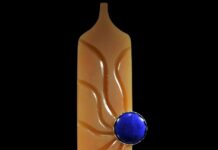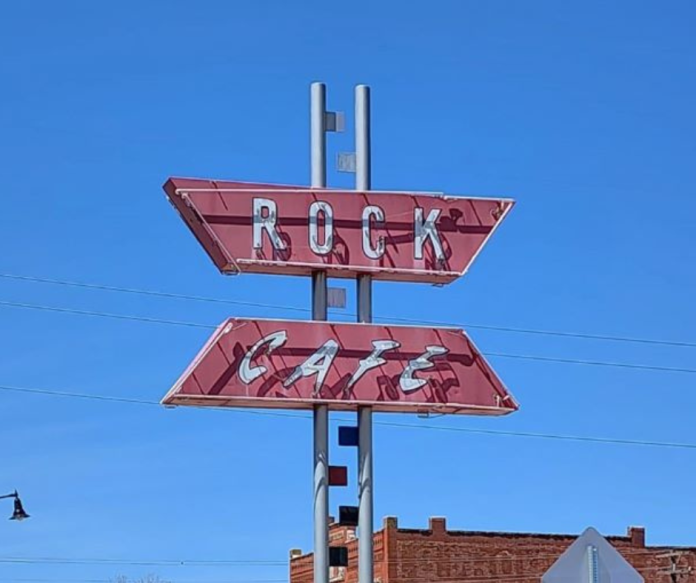
The Rock Cafe, Oklahoma, is a mom-and-pop spot that’s fun to visit and a fascinating rockhounding spot. Its claim to fame is serving as the inspiration for “Cars,” the hit Pixar movie.
Planning Route 66
Oklahoma is the birthplace of Route 66, and Cyrus Avery, of Tulsa, is known as the “Father of Route 66.” Avery served on various road-associated commissions. In 1925, he nabbed a seat on the committee of highway officials who were creating a proposed national highway system, as well as a numbering scheme to go with the map.
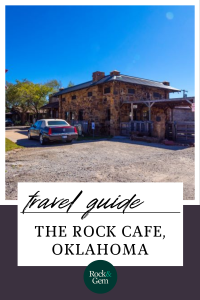
A major promoter of a highway from Chicago to Los Angeles, Avery formed the U.S. Highway Association, and he also coined the term “Main Street of America” in reference to that Chicago-to-LA highway -Route 66. A businessman, Avery operated the Old English Inn and Service Station on the outskirts of Tulsa. So, when Route 66’s 2,448 miles of roadway launched, Avery made sure travelers couldn’t miss his establishments.
In tandem with U.S. highway creation, the 1920s and 1930s left gargantuan, permanent footprints on Oklahoma. The Great Depression (1929-1933) plunged the nation into a suffocating vice grip with intense aftershocks. And things worsened in Oklahoma because of the Dust Bowl (1931-1939) which brought historic and unbelievable killer dust storms. Oklahoma historian and award-winning author John J. Dwyer said drought, worn-out land, and land ownership issues were worsened by unpredictable market fluctuations, making Oklahoma’s situation overwhelming.
Despite a great exodus, many Oklahomans hung on and endured. With their pluck and grit, they created a phenomenal list of enterprises that included a menagerie of shops, service stations and motels.
The Rock Cafe
The Rock Cafe, of Stroud, Oklahoma, remains as one of those mom-and-pop enterprises. Local man Roy Rieves and his family were recovering from the Great Depression. He knew about Route 66 and purchased lots on the highway. In 1936, he paid $100 for the land, and $5 for local Kellyville, Oklahoma, sandstone. Mixed-by-hand concrete made load-by-load in a wheelbarrow, formed the structure’s foundation. Rieves built the eatery’s stone exterior and named the location after the area’s sandstone. Rieves did almost all of the construction himself, working for about three years on the project.
Rieves started building in 1936, and opened his café in 1939, never planning to run the eatery himself. On August 4, 1939, the location officially opened with Miss Thelma Holloway as manager. Neon signage went up. And during World War II, “The Rock,” as it is still known, doubled as a busy Greyhound bus stop with military coming and going and eating and saying goodbye to and reuniting with family, friends and sweethearts.
Changing with the Times
Management changed periodically. But then in 1959, Mamie Mayfield took the driver’s seat. She not only kept the Rock Cafe, Oklahoma, running around the clock, but she also changed the venue’s dynamics. The location, halfway between Tulsa and Oklahoma City, became a back-in-the-day CB, pager, cell phone and internet system. Truckers from coast to coast knew about the Rock and wheeled in to pick up messages. Wives called the Rock and left messages that were pinned to the wall for their traveling husbands to find. Mamie even gave students the green light to push the jukebox to the window so they could dance outside.
Different players came and went at the Rock. Then in 1993, Dawn Welch stepped in as owner of the restaurant. Welch steered the iconic café onto the National Register of Historic Places.
Just three years prior, Tulsan Michael Wallis’ “Route 66: The Mother Road” hit stands and the award-winning book revved up new interest in the route. Wallis is a Route 66 expert who has traveled the highway throughout his life.
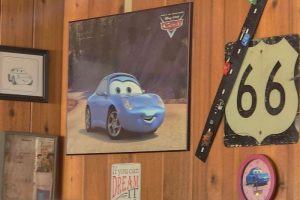
Photo by Lisa Ann Steen
What Movie Was the Rock Cafe, Oklahoma Featured In?
Cue Pixar Director John Lasseter of “Toy Story” and “A Bug’s Life” fame. In 2000, he and his family embarked on a two-month road trip. On returning home, Lasseter wanted to tell another animated movie story, and in so doing, celebrate Route 66. While he and his team researched Route 66, they stumbled onto Wallis’ book, realizing they found a gem.
They hired Wallis as chief consultant. Then the Pixar team, including animators, set out to cruise Route 66 a few times with Wallis as their official tour guide. Not only was the team looking for story inspiration, they were also scouting for real people on the route, after whom they could fashion movie characters. The results yielded the wildly popular animated “Cars” movie which raced across screens nationwide in 2006, followed by “Cars 2” in 2011.
But shifting into reverse for a moment, when scouting for inspiration, Wallis took the Pixar team to Route 66 highpoints, including the Rock Cafe, Oklahoma, where the team met Welch. The Pixar gang fell in love with her and the Rock. In fact, Pixar used Welch as their inspiration for Sally Carrera, the blue Porsche who runs the Cozy Cone Motel. Plus, Wallis’ deep, booming voice served as the voice of the sheriff of Radiator Springs in both “Cars” movies.
Lasseter and the team were so impressed with Welch that they sent her all sorts of “Cars” movie props for the Rock’s landscaping and a plethora of “Cars” memorabilia to decorate the interior.
Fire Claims Cafe, But Not the Rocks
The Rock Cafe, Oklahoma, hit a major pothole in May 2008, when the restaurant burned to the ground, leaving only the rock exterior and the grill. Welch rebuilt, again using Kellyville sandstone for the exterior. Lasseter heard about the fire and sent Welch new “Cars” film props for the grounds and memorabilia for interior decór.
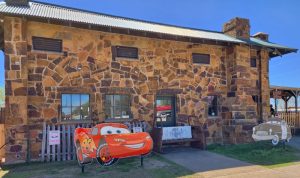
Photo by Lisa Ann Steen
Eating at the Rock Cafe, Oklahoma
Welch has a background in cooking. And she wants diners to feel like their grandmothers made their meals. Her slogan is “food and history – we live it every day.” So, the Rock Cafe, Oklahoma, continues to soar as a pop culture icon on Route 66.
The most popular menu choices include Welch’s great grandma’s peach cobbler, and bread pudding with rum sauce (and you can get a scoop of ice cream on that). Much-loved entrees include buffalo burger, as well as jägersnitzel, which is a breaded and fried pork cutlet topped with creamy bacon, onion and mushroom sauce served with späetzle (German-style noodles the size of macaroni noodles).
The menu is too long to list but includes fried pickle slices which are breaded and fried hamburger pickles served with ranch dressing. And by the way, they were the inspiration for Carsland’s Cozy Cone’s Dill Pickle Popcorn. There are also lightly breaded onion and jalapeño rings known as cowboy candy; fried green tomatoes; a patty melt; chicken fried steak; Bev’s Famous Meatloaf; fried catfish; Bobbie’s Indian Taco; a Rueben; and a BLT, to name a few.
Dessert options abound and include an ice cream float, plus one of Wallis’ favorites, poor man’s pecan pie which is a warm oatmeal-cookie-type pie served with vanilla ice cream.
Modern Fame
Welch has driven the Rock Cafe, Oklahoma, into rock star status. Guy Fieri’s “Diners, Drive-ins and Dives” spotlighted Welch and the Rock in 2007. In 2009, The Oklahoman newspaper named her “Woman of the Year.” In February 2010, the Oklahoma State Senate honored Welch. With a background as a chef, she penned “Dollars to Donuts: Comfort Food and Kitchen Wisdom from Route 66’s Landmark Rock Cafe,” published by Rodale.
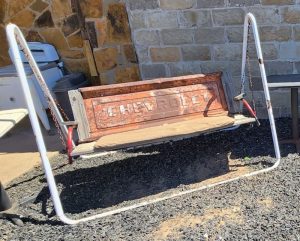
Photo by Lisa Ann Steen
Sandstone From Several Locations
As for that Kellyville sandstone from which the Rock Cafe, Oklahoma, was cobbled, the stone remained after workers carved through the area to construct Route 66. Workers moved the sandstone rocks out of the way as they prepared the area for the new highway.
Oklahoma geologists claim the state has a lot of sandstone from different formations. As for which type of sandstone the Rock was made from, there are several options. One choice is that the sandstone is Cheshewalla Sandstone at the base of the Vamoosa Formation. It’s usually well indurated so it could be used for building material and exposures of it are not that far from Stroud. A second option is that the sandstone is from the Dewey Formation. The Dewey is sometimes a sandy limestone and at others a limey sandstone, which makes the sandstones in the Dewey well indurated at times. The color would be close, as well.
A Unique Highway
Debuting when gas cost a quarter a gallon, Route 66 spanned over 2,000 miles, crossed three time zones, and blazed across eight states -Illinois, Missouri, Kansas, Oklahoma, Texas, New Mexico, Arizona and California. It took workers from 1926 to 1937 to pave the entire stretch. For some towns sitting on Route 66, such as Yukon, the highway was the first paved road in town.
Route 66 is unique in many ways. Planners used existing and historic roads, even old, covered wagon trails and cattle trails, on which to build the highway. It connected the main streets of small towns, which benefitted those towns. Also, one of the route’s goals was to help farmers transport crops.
John Steinbeck’s “The Grapes of Wrath,” in which he labeled Route 66 as “The Mother Road,” took Route 66 into American homes. And musicians from Nat King Cole to The Rolling Stones immortalized Bobby Troup’s 1946 song “Come Get Your Kicks on Route 66.” In 1952, the U.S. Highway 66 Association nicknamed the road “The Will Rogers Highway,” giving another nod to Oklahoma.
National Historic Trail
Route 66 hit a snag when modern-day traffic required bigger and better highways, and the route couldn’t handle that. So, the roadway was decommissioned in 1985 and replaced with interstates. But 80 percent of Route 66 still exists. And in 2018, Congress tagged the road as a National Historic Trail. For those wanting to see America, rather than zoom past it, Route 66 still offers global travelers a hearty taste of the American narrative, but at a slower pace with time to breathe and relax and soak it all in.
Oklahoma has the most remaining miles of the iconic highway, which will celebrate its centennial in 2026. As the highway has in the past, it is still connected to the ideas of freedom, opportunity and adventure.
This story about the Rock Cafe, Oklahoma, previously appeared in Rock & Gem magazine. Click here to subscribe. Story and photos by Carol Mowdy Bond.











